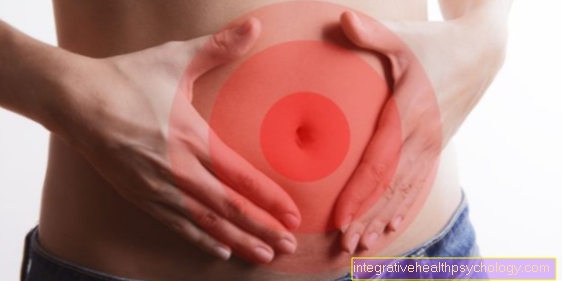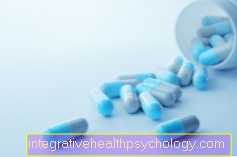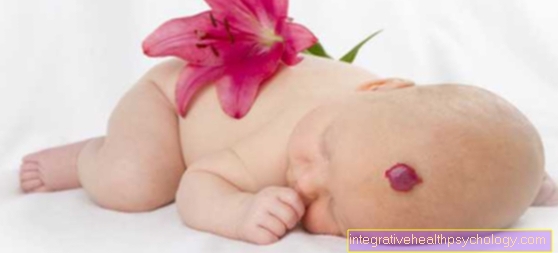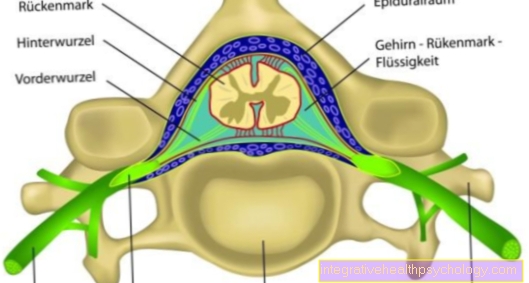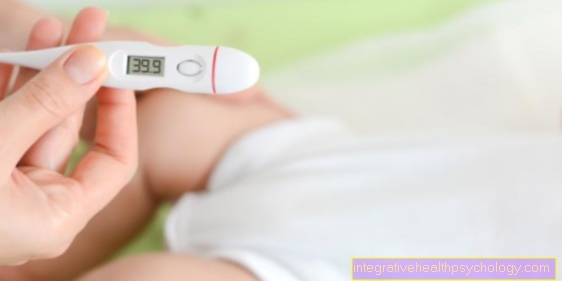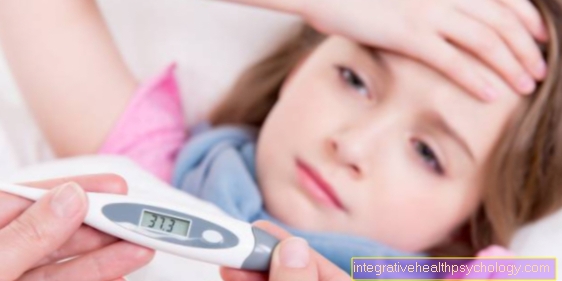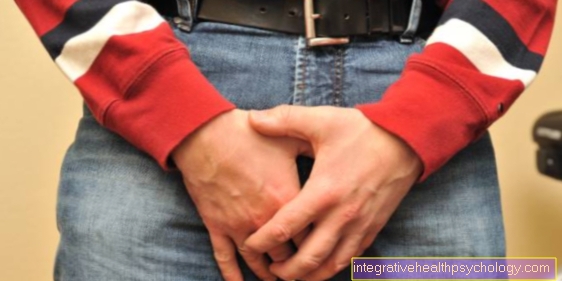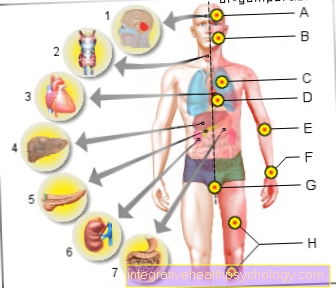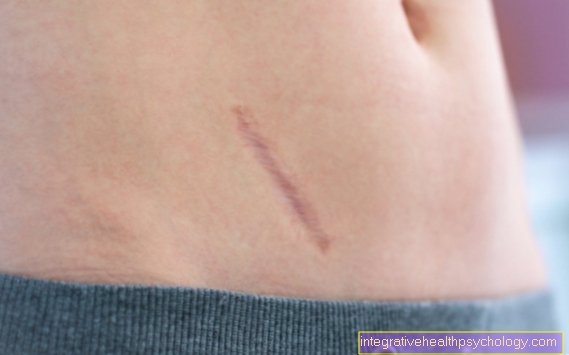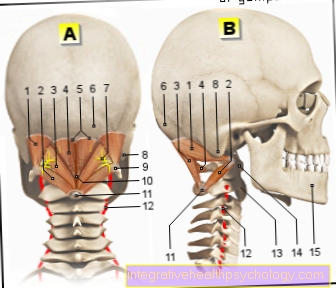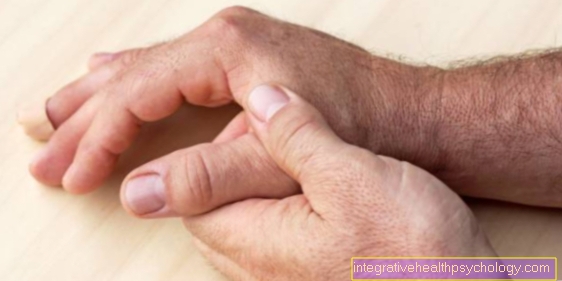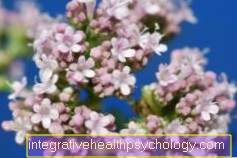Warts
introduction
"Wart" (verruca) is a collective term for a large number of (almost always) benign skin changes that can be triggered by many different pathogens. By far the most common cause of warts, however, are the so-called human papillomaviruses (HPV), with which one can become infected through contact or smear infection.

It is assumed that one in two people will suffer from a wart at least once in their lifetime. In principle, warts can develop at any age, with children being affected much more often than adults. Warts can look very different from one type to another.
Also read: Warts in children
Usually, however, they are either flat or at least only slightly raised, relatively small and sharply defined. As a rule, warts can be treated well, but since the risk of infection and relapse is relatively high with warts, warts can recur again and again in the course of life.
Causes of warts

Apart from the so-called age warts, which are not actually warts in the strict sense, all warts are the expression of a viral infection. There are now over 60 known viruses that can cause warts.
The most common are the human papillomaviruses (HPV), which are responsible for vulgar warts (common warts), genital warts, flat warts and brush warts, and the molluscum contagiosum virus (MCV).
First of all, you have to come into contact with a virus that caused it. This often happens, especially with warts, in public facilities such as swimming pools, saunas or hotels, where many people walk around barefoot and, if necessary, towels or the like are shared. For a virus to actually cause a wart, several factors must come together.
On the one hand, there must be a defect in the skin through which the virus can enter, since the intact skin provides sufficient protection against these viruses. However, these defects are usually so minimal that those affected actually do not even notice them.
Whether or not there is an infection also largely depends on a person's immune status, i.e. how well the body's defenses work. In addition to the not yet so pronounced hygiene behavior of children, this is another reason why this age group in particular often develops warts: In young children, the immune system is simply not yet fully developed.
Because of the limited body's defenses, people with certain underlying diseases or after taking certain immunosuppressive drugs (such as cortisol) also suffer from warts more often.
It also plays a role whether the immune system has come into contact with the specific pathogen before. Then it may be that special cells already exist that are specialized in killing this one pathogen, which can then fight the invaded virus so quickly that the warts cannot even develop.
Read more on the subject here: The viral wart.
Symptoms of warts
The characteristic appearances of various common warts are briefly described in more detail here.
- Plantar warts (Plantar warts, mosaic warts, plantar warts, verrucae plantares) also arise from papillomaviruses. However, after infection, it can take up to several months for this type of wart to become visible on the sole of the foot.
A distinction is made between this type Plantar warts and Mosaic warts. Plantar warts grow very deep into the skin, can sometimes become keratinized on the surface (calluses) and contain several black dots. Because deeper layers of the skin are also affected, this type of wart can cause considerable pain, especially when pressure is applied to the relevant area, i.e. often when walking. This pain can be aggravated by the fact that plantar warts can occasionally even grow to the bone and irritate the sensitive periosteum here.
Mosaic warts, on the other hand, do not grow in depth, but in width. They are extremely flat, but can occur in very large numbers and in beds. There is usually no pain with mosaic warts. A differential diagnosis is important in the case of plantar warts, as the common warts on the soles of the feet also occur regularly.
- Dellar warts (Mollusks, Molluscum contagiosum)
In contrast to the other warts, the dellar warts are caused by a Dna virus from the group of smallpox viruses called Molluscum contagiosum caused. They can be found anywhere on the body, but are increasingly found on the hands, fingers, arms, face, neck and trunk. Most warts are about the size of a pea, light red, knot-shaped and have a smooth surface that often appears shiny. Dell warts have a dent in the middle, which is the origin of the name of this type of wart. When pressure is applied to the wart, a whitish liquid containing virus bodies is emptied from this dent.
You can find a lot more information on these topics at: Dellar warts
- Age warts (senile warts, verrucae seborrhoicae)
The cause of this type of warts is not yet known, we only know that their formation is favored by increased solar and UV radiation. Age warts mainly develop from the age of 50. They are light brown to black, mostly small, but can sometimes reach the size of a bean, often with a rugged surface and they can affect the skin over large areas. These skin changes are sometimes itchy, but otherwise they are harmless and not contagious. Malignant changes have only been described in a few exceptional cases.
- Vulgar warts (Barbed warts, Verrucae vulgares)
This type of warts is by far the most common, accounting for around 70% of all warts. Typically, vulgar warts form on the face, fingers, and under the nail plate.
At first they are about the size of a pinhead to a pea, but in the further course they can increase in size and practically proliferate. These growths are often described as "cauliflower-like" because of their appearance. The nodes are whitish, hard, rough and often also scaly. Sometimes several small "daughter warts" develop around the original wart. The causative agent of these warts are the human papillomaviruses 1, 2, 4 and 7.
- Genital warts (Genital warts, condylomata acuminata)
These warts are also caused by HPV, but primarily HPV 6 and 11, and are usually transmitted through unprotected sex.
They arise either in the area of the genital organs (i.e. on the vagina, the external female genital or the penis) or in the anal region. Genital warts are initially only a few millimeters in size and very light, whitish or flesh-colored, which is why they are not easy to recognize at first. Sometimes, however, they grow considerably in size over time and form so-called wart beds.
There are also meat warts, flat warts and brush warts.
Diagnostics for warts
Due to the characteristic appearance, the doctor can usually easily make the diagnosis in the form of a Eye diagnosis put. Those affected can often even make the diagnosis themselves, especially if they have already had multiple experiences with warts.
However, there are some types of Skin cancer some wart shapes occasionally can look very similar, it makes sense to consult a doctor in the case of newly discovered skin changes in order to obtain a reliable diagnosis. In case of doubt this can be a Tissue probe with the help of which a malignant tissue growth can be excluded.
Removal of warts

The Therapy / removal of warts is dependent of their
- Pathogen
- Degree of expression and
- Localization.
There Age warts harmless and not infectious are these usually not treated at all.
For all other warts lend themselves various possibilities for therapy / removal. With these other types of warts, too, there is initially the option of simply waiting. In many Cases, warts go away on their own, sometimes even after they have existed for weeks or even months. Since they do frequent itching, pain and / or a cosmetic problem patients usually want a therapy after all. Which of the many options makes the most sense in a specific case is best discussed with a doctor. In principle, you can use warts
- Cyto- or virustatics
- icing (Cryotherapy) or one
- surgical removal to treat.
1. Cyto- or virus statics: Initially, warts will usually be treated with a little invasive and little painful method initiate. Certain ones are available for this Creams, ointments, solutions and varnishes with active substances that fight certain viruses directly (antivirals such as cidofovir) or cytostatic agents, the the Cell growth or cell division inhibit (for example fluorouracil or podophyllin or the more potent podophyllotoxin).
2. In cryotherapy (Freezing) is applied with the help of a so-called applicator Coolant (mostly liquid nitrogen) on the wart applied. This remains for a few seconds on the wart. This icing process is repeated several times. The goal is that Kill cells in the top layer of skin and subsequently to be removedso that the wart practically "grows out" with the newly growing lower skin layers. A common side effect of freezing is the creation of a Icing bubble.
3. Surgical removal of warts is only used when other, less invasive procedures have not worked. As part of an operative therapy, there are again several options available.
- "Sharp Spoon": The warts are most often treated with a so-called "sharp spoon" away. This procedure is particularly suitable for warts that have grown relatively deep, such as plantar warts. In local anesthesia the wart can then come in handy scraped off become.
Depends on the Expansion of the wart, of the nature and des Healing potential of the fabric can die subsequent healing phase take different lengths of time. Unfortunately, this type of removal is often not possible with you negligible blood loss and partly with severe post-operative pain hand in hand.
- Electrocoagulation: In another variant, the wart is removed with the help of Electrocoagulationso by putting the skin on the affected area thermally destroyed. This method can be used with a massive scarring go along, especially on the soles of the feet.
- Removal with laser: Finally there is still an option, one Laser to remove the wart to use. Either the laser is used like a "sharp spoon" and cuts out the wart or a dye laser is used to remove the Occlude blood vessels and the wart, so to speak dry out from the inside out can.
Disadvantage: - Painfulness and the need for many sessions
advantages: Relapses (recurrences) are rarely described.
Read a lot more information on this topic at: Removing warts
Wart patches
Are wart patches without prescription and have a relatively simple functionality. In the pavement is Salicylic acid or Lactic acid contain. These acids attack the top layers of the skin wart on. This softens the wart on the surface and the calloused spots come off by themselves or can be removed with a file. The wart patch should last for about 3 days not from the Wart removed and glued on as watertight and airtight as possible, so that an ideal effect can be guaranteed. Furthermore, it should be ensured that the plaster does not move when rubbed (e.g. on the Sole of the foot) replaces.
After the exposure time of 3 days, the plaster can be removed. In the next step, the softened and possibly already slightly dissolved skin should be treated with a file, Planer or pumice be removed. The rule here is that as much skin as possible should be removed until the softened upper layers can no longer be seen. Generally only should so much to be planed, like it no pain caused. In the following days, after bathing in warm water (a few minutes), you can try to file off additional skin. If the wart is not gone after this point in time or if it returns, a wart patch can be stuck on again and the process can be repeated.
Since the wart patch the The cause of the warts - the virus - does not kill them, but only the cells in which they are present, care must be taken that the treatment is carried out until the wart has really disappeared completely, otherwise the viruses from the remaining cells can lead to renewed growth of the wart.
If the wart does not go away even after several passes, you must consider using another remedy and consulting a doctor to rule out other reasons for the increased growth of the wart.
Wart remedies
In addition to the use of plasters, a very frequently used form of therapy is this Applying tinctures. Similar to the plaster, the functionality of these tinctures is based on Acids. Often included Salicylic, Milk- or Formic acid. As with the plaster the acids dissolve the superficial keratinized skin areas and make it easier to remove them.
Other tinctures contain other acids in addition to these acids strongly corrosive acids or Bases such as trichloroacetic acid or potassium hydroxide. Here care must be taken that the tinctures not in the eyes arrive and that the surrounding skin possibly through fatty creams is protected.
Another possibility is the one-timeIcing of the wart. Two gases are mixed by pressing a button in a small "plastic bottle" (applicator), which creates a mixture with a temperature of below -50 ° C. This plastic bottle is then pressed onto the wart for about 20-60 seconds. This can be a painful process. The rule here is that the application is only effective if the wart is completely iced up. If the wart does not heal or if the wart returns, the process must be repeated.

Prophylaxis of warts
In order to prevent the development of warts, almost only that helps tain good personal hygiene. This includes always using your own towels, washcloths and clothes, if possible in public facilities not barefoot runs and the Cleans skin regularly.
As the causative agent of warts, however so common however, it is difficult to consistently avoid the risk of infection. Only for Genital warts (HPV) has existed since 2006 effective vaccine.
Freezing of warts

The Freezing of warts, also Cryotherapy called, describes the distance from superficial warts through the use of cold. This treatment is mostly used liquid nitrogen used as a spray or solution on the wart is applied. The affected tissue is damaged by the cold and dies.
This method is especially useful for warts that have insensitive parts of the body grow regardless of the type of wart and is therefore unsuitable for use in sensitive areas such as the eyes or on mucous membranes.
The procedure of icing is simple and can either independently or through the doctor be made.
After the relevant Body part cleaned was the cold by the doctor about a probe placed exactly on the wart.
In pain-sensitive patients, the wart can do something before the freezing substance is applied stunned become. The cold is through the use of liquid nitrogen, Laughing gas or Dry ice evoked. After freezing, the wart dies under education of small Ice crystals inside the cell and it is possible that a bladder arises in the area of the icy wart, which disappears in the following days.
Then will be under the bladder new, healthy skin cells to emerge. Usually it is therapy after one application successfully and the wart disappears. If this is not the case, the wart can be iced up again after two to three weeks so that it does not develop again but perishes completely.
In the self-employed icing from warts come common Sprays for use, which are available in the pharmacy. This approach should be carefully planned to ensure that the growth in question is actually a wart.
When buying the means for icing you should look into the pharmacy seek advice. In some situations, however, we strongly advise against acting independently.
For example at Diabetics, because in these patients the Impaired wound healing is. Furthermore, the icing should be Children under four years of age through a doctor can be made, just like with warts that are located on sensitive parts of the body. Seeing a doctor is advisable as it will freeze and remove the warts more effectively and safely.
Read more on the topic: Freeze warts
Warts removal by laser treatment
The Wart removal by means of laser is especially in severe Wart disease Means of choice when other methods have failed.
In principle, there are two different methods of Laser wart removalwhich one, however, both times stunned becomes.
In the first method, the wart is through a Laser scalpel cut out. Are problematic here possible pain after treatment and Scarring processes in the places where the laser was used.
The second method is something gentler, but for that more tedious. In several sessions, the Blood vesselsthat take care of the warts, destroyed. As a result, the wart can no longer keep up Nutrients are taken care of and dies. The number of sessions depends on the size of the warts.
The latter method has proven itself in recent years and is therefore now explained in more detail:
The begins three days before the laser appointment Pretreatment the wart by means of a Plasterwhich Substances that contains the wart something soften supposed to keep the wart immediately in front of the Irradiation something can be scraped off and the laser beams can penetrate deeper into the skin.
After that Skin area around the wart stunned became the laser used to supply the Blood vessels the wart too to destroy. After the treatment, the skin area is cooled. At a follow-up appointment (usually 6 weeks) the wart will be removed if it has not fallen off on its own or the laser treatment will be continued if the first session was not sufficient.
For one quality and scar-free healing it is important that the emerged Wound clean is held and so no bacteria or Viruses cause infection.
Daily Dressing change ensure that the Wound secretions removed and the place is kept as dry as possible. Especially after Wart removals to the Feet it is important that the places where the warts previously sat are relieved. If you consider all of this, a laser treatment can achieve a very pleasant result and remove warts over the long term.

